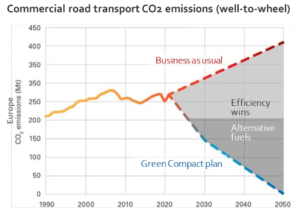IRU’s Green Compact is a collective global action to achieve carbon neutrality in commercial road transport by 2050. The Green Compact outlines a roadmap for the industry to meet global decarbonization goals while continuing to provide transport services for the people, communities, and economies that depend on them.
Five pillars
Based on the more comprehensive well-to-wheel approach for measuring CO2 emissions, IRU’s Green Compact studies, maps, and tracks action across five pillars:
- Alternative Fuels – Accelerated implementation of low- and zero-carbon fuels, including electric, hydrogen, biodiesel, biogas, and e-fuels
- Efficient Logistics – Digitalisation, automation, advanced routing, eco-trucks, and retiring
- Efficient Vehicles – Materials and design, tires, engine improvements, lubrification, and fleet renewal cycles
- Efficient drivers – Driver monitoring, training, education, and certification
- Collective Mobility – Integrated ticketing and timetables, service frequency, terminals and infrastructure, and awareness and promotion.
Three scenarios
Three scenarios to fully decarbonize commercial road transport by 2050 were assessed based on emissions reduction potential, impact on transport services, and investment. All three scenarios include different mixes of electricity, hydrogen, carbon-neutral bio, and synthetic fuel fleets over time.
1. Hydrogen Push: this scenario assumes a concerted political, financial, and industrial effort to boost the use of hydrogen based on greater availability of economically viable clean hydrogen fuel thanks to generous financial subsidies.
2. Heavy Electrification: this scenario assumes political will, public policy, and financial capacity to prioritize electrification, and clean electricity supply from renewable sources, such as solar and wind, is increased.
3. Efficiency Focus: this scenario focuses on maximizing the use of proven efficiency measures through to 2050, accelerating energy efficiencies in the shorter term and allowing more time to phase in alternative fuels over the longer term.
Including private and public sector investment cumulatively to 2050, according to IRU, the Efficiency Focus scenario costs €1.06 to remove one kilogram of CO2e, compared to €1.28 for the Heavy Electrification scenario and €1.41 for the Hydrogen Push scenario.
The Efficiency Focus scenario is up to 11% more effective in removing CO2 emissions from commercial road transport than the other two scenarios. This is due to an immediate focus on efficiency measures with existing powertrains, continuing with the steady operational implementation of alternative fuels powertrains through to 2050.
The Efficiency Focus scenario causes less economic growth and social inclusion disruption because it allows more future transport demand to be fulfilled: 10% more goods transport and 75% more passenger transport than the other scenarios.
The Efficiency Focus scenario costs up to 19% less for governments and businesses; in other words, it will result in savings of at least €1 trillion through to 2050.
Efficiency measures are estimated to account for 51% of CO2 emission reductions by 2050. And 49% of the CO2 emissions reductions to make the sector carbon neutral by 2050 can be achieved by implementing feasible and economical alternative fuels.

New research
Based on common principles and a standard methodology, the Green Compact gathers data and evidence across the five pillars, develops practical models, tests concepts, shares best practices, and scales up proven solutions.
The first major research project focused on Europe. It assessed three scenarios for the industry to fully decarbonize up to 2050 based on different energy sources, including electricity, hydrogen, and biofuels.
Covering the EU27 and ten other European countries, the research compared the investment needed to cut CO2 emissions to reach the 2050 goal regarding fleet renewal, energy production and distribution, and infrastructure.
Global, regional, local
However, countries and regions have vastly different transport and energy landscapes. The specific mix of different solutions that will help advance one country’s commercial road transport sector to carbon neutrality will not work in other countries.
The Green Compact is therefore built on regional flexibility in terms of evidence gathering, testing and scaling up of solutions. New models and tools are being developed based on the current research that will apply to all regions of the world, all types of road transport operations, and different policy-making levels.
Source: IRU






